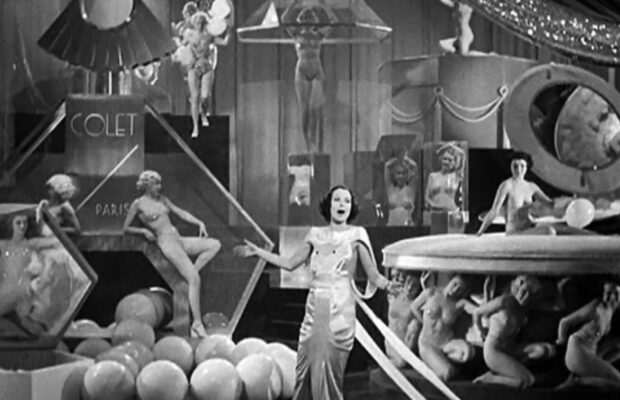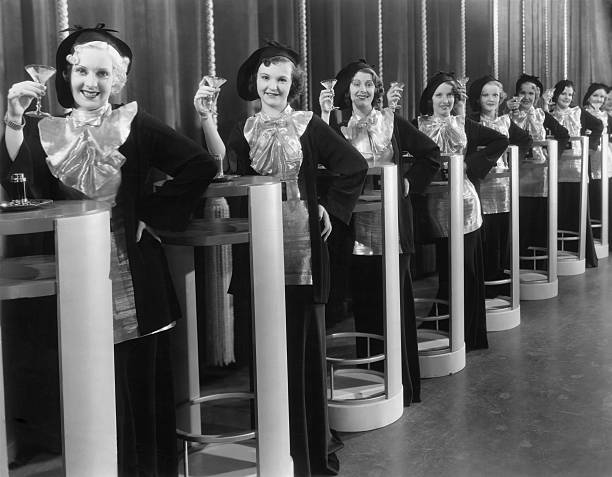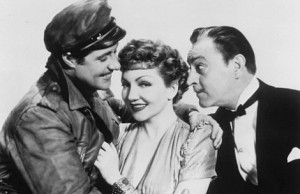Murder at the Vanities (1934)

Toronto Film Society presented Murder at the Vanities (1934) on Monday, July 28, 1986 in a double bill with Midnight as part of the Season 39 Summer Series, Programme 4.
Production Company: Paramount. Director: Mitchell Leisen. Producer: E. Lloyd Sheldon. Screenplay: Carey Wilson, Joseph Gollomb, Sam Hellmann, based on the play by Earl Carroll and Rufus King. Cinematographer: Leo Trover. Music: Leo Robin and Ralph Rainger.
Cast: Carl Brisson (Eric Lander), Victor McLaglen (Bill Murdock), Jack Oakie (Jack Ellery), Kitty Carlisle (Ann Ware), Dorothy Stickney (Norma Watson), Gertrude Michael (Rita Ross), Jessie Ralph (Mrs. Helene Smith), Charles B. Middleton (Homer Boothby), Gail Patrick (Sadie Evans), Donald Meek (Dr. Saunders), Otto Hoffmann (Walsh), Charles McAvoy (Ben), Beryl Wallace (Beryl), Barbara Fritchie (Vivien), Toby Wing (Nancy), Lona Andre (Lona), Colin Tapley (Stage Manager), William Arnold (Treasurer), Arthur Rankin (Assistant Treasurer), Cecil Weston (Miss Bernstein), Hal Greene (Call Boy), Teru Shimada (Koto), Roy Crane (Assistant Stage Manager), Ted Oliver (Murdock’s Chauffeur), Mildred Gover (Pearl), Stanley Blystone (Policeman), Micke Pat Donovan (Sergeant), Howard Mitchell (Plain Clothes Man), Betty Bethune (Fat Charwoman), Clara Lou Sheridan (Lou), Gwenllian Gill (Gwen), Leda Necova, Anya Taranda, Wanda Perry, Evelyn Kelly, Dorothy Dawes, Ernestine Anderson, Laurie Shevlin, Ruth Hilliard, Constance Jordan, Marion Callahan (Earl Carroll Girls).

Murder at the Vanities was Leisen’s fourth picture, and distinct change of pace from Death Takes a Holiday: a combination of murder mystery and spectacular musical. And nothing so dramatizes the integration–somewhat tongue in cheek–of the two forms than the number, “Where Do They Come From and Where Do They Go?” Laden with overt nudity and innate suggestiveness, this number is halted abruptly when blood drips down from the catwalk above the stage on to one of the naked chorines. The first murder has been committed. And skilfully orchestrating the whole combo is Mitchell Leisen himself, making an appearance as the orchestra leader in the pit.
Obviously this is not a film to be taken too seriously, but rather to be thoroughly if merely enjoyed. The most famous musical piece in the film, led off by the statuesque and soon to be murdered Gertrude Michael, is the notorious “Sweet Marijuana”, which has to be heard to be believed. And all this in the very year Will Hays got real teeth into his code.
The lovers in the film, whose marriage is the looked-for climax, are Carl Brisson and Kitty Carlisle. Brisson was, in Leisen’s phrase, “the Bing Crosby of Sweden” (he was in fact Danish); a former boxer–he appeared in Hitchcock’s silent The Ring–and a very vain man (again according to Leisen), Kitty Carlisle is of course still with us, if only on reruns of To Tell the Truth and occasional talk-show appearances as Moss Hart’s widow this past quarter century. Her voice and style have dated somewhat in fifty years, and one remembers unsympathetic laughter at her rendering of “Love in Bloom” opposite the American Crosby in She Loves Me Not, as well as at her “Alone” in the Brothers’ A Night at the Opera (where, however, Allan Joes is more risible). She appeared in only half a dozen pictures, and her voice, though of her period, is distinctively and distinctly pleasant, and here part of the general gaiety.
Those who find the lovers unappealing may find a more congenial pair in Jack Oakie’s press agent and Victor McLaglen’s bone-headed detective. As Variety noted: “McLaglen shares with Jack Oakie the comedy burden and for each it’s a strike. Both are at their best, and it would appear that the casting in this and other respects for Vanities is entitled to a bow.”
The film is set amidst a performance of Earl Carroll’s Vanities, and though Carroll does not appear–Leisen walked off the set when he heard Carroll was hanging around offstage–the film keeps fairly rigidly to the format of a stage performance: the camera does not suddenly leave the proscenium to seek out vast expanses of space,, as so often in the staged films of the period (Could any Busby Berkley number fit on a real stage?). But if Carroll, the rival in his day of both George White and Florenz Ziegfeld, does not appear, Duke Ellington’s hepcats do, giving the film something of the quality of Leisen’s later Big Broadcast pictures.
As the New York Times intoned, “Yes, the spectacular items are far more interesting than the story.” “Where Do They Come From,” “Sweet Marijuana”, and also those wonderful fans breaking like waves in “Live and Love Tonight,” an idea Leissen acknowledged he had got from Sally Rand, are all part of the general delight if not teaching. So sit back, relax; and men, try to keep your eyes from popping out of your heads!
Notes by Barrie Hayne

Sunday Afternoons at the Paradise
Join TFS for Season 78’s Sunday Matinée Series generously sponsored by our good friend, author and documentary filmmaker, Mr. Don Hutchison. Please save these dates and visit us regularly...







